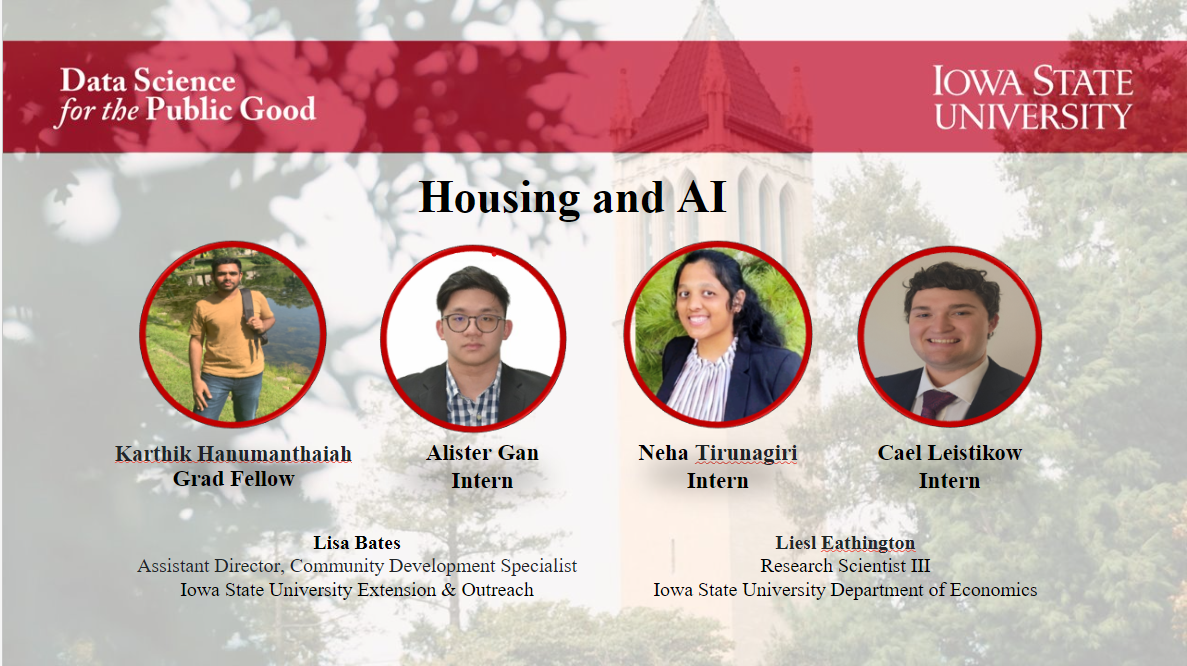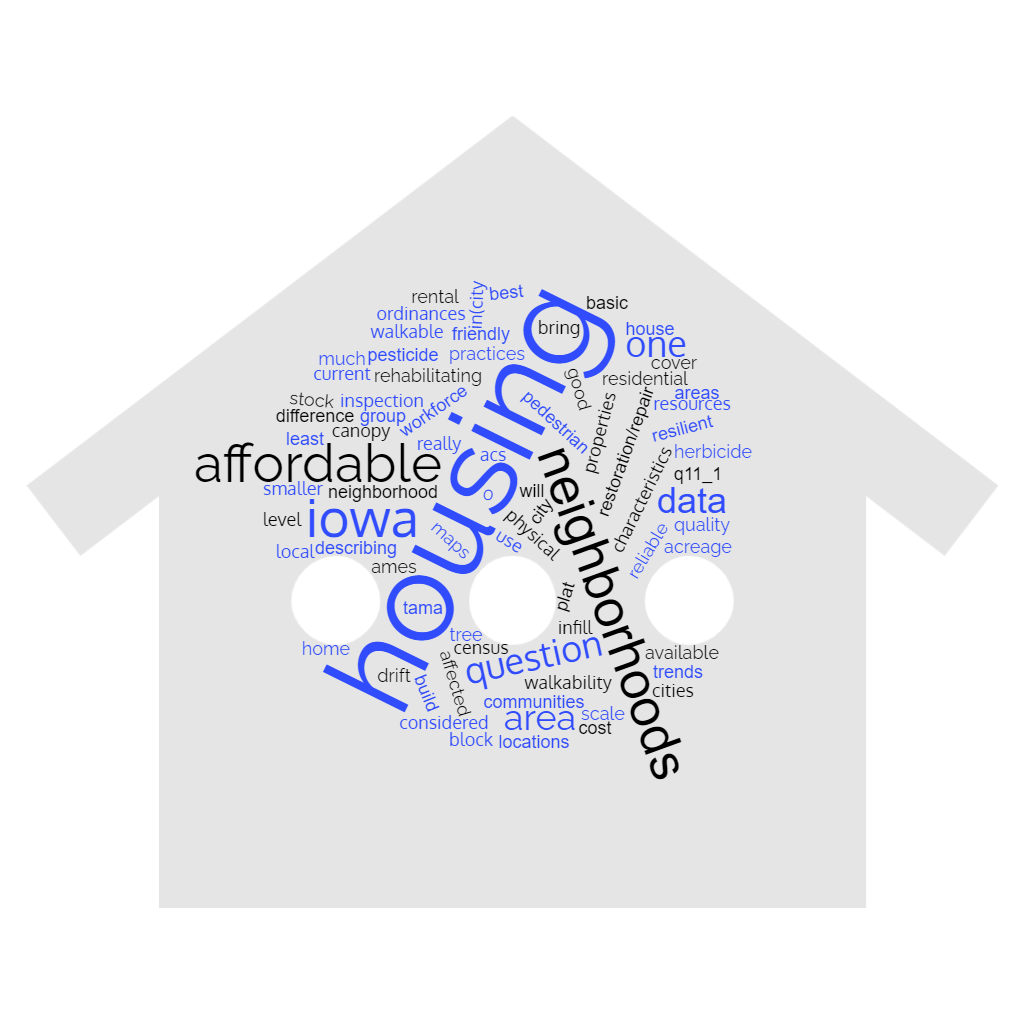Introduction
Research Question
How can AI more effectively distribute up to date housing related information to communities in Iowa?
Goals
The ultimate goal of this project was to develop an accurate AI Chat bot that is able to efficiently provide information to the user. The Chat bot allows easy access to a wide variety of roles ranging from new home buyers to policy makers. The information also contains the most up to date and most relevant to the user to make data comparisons for well informed decisions while also providing relevant visualizations for better understanding.
Presentation Structures
Project Overview
Technology Overview:
Machine Learning: Enable AI to imitate how humans can learn and speak to bridge the gap between AI and human communication
Large Language Model (LLM): A subtype of Machine Learning that has been trained on a vast amount of text data. It learns to understand and generate responses to address a user query, making a human interactions with the Chatbot smooth and resourceful.
Semantic Segmentation: Predictive image segmentation that assigns classification values to pixels based previously defined pixel values. Helps distinguish between various object within an image.
Map Generation: Map generation transforms geographical data into interactive visual maps, making it easier for users to explore and understand spatial patterns and trends. By visualizing data on maps, users can identify geographic distributions, analyze regional differences, and make informed decisions based on location-based insights.This provides a clear and intuitive way to interpret complex geographic information.
Nova Ondemand (High Performance Computing): Platform to get access to vast computer resources to be able to run our AI Chat bot.
Data Source Overview:
American Community Survey (ACS): Survey to calculate different demographics aspect about the nation and the people on an annual basis. We are using the ACS 5-year (2017 - 2022) for our data.
Data For Decision Makers: A brief reports that represent a profile and snapshots of a city’s, county’s, and a region’s demographics, economic, social, health and housing characteristics.
Rural Housing Readiness Assessment (RHRA): A tool that helps communities self-assess their housing needs and guides them in the decision-making process when addressing those needs.
United States Department of Housing and Urban Development (HUD): One of the executive department in the U.S. federal government that works on administrating federal housing and urban development laws.
United States Department of Agriculture (USDA): Federal executive department that helps in developing and executive federal laws related to agriculture, forestry, farming and rural economic development.
National Agricultural Imagery Program (NAIP): Federal aerial imagery database that is made up of high resolution images of the United States, taken during the agricultural growing season.
Use Cases
Use Case 1: General Housing Policy
Use Case 2: Local Housing Statistics
Use Case 3: Building Footprints
Conclusion
Project Goals
Wrap Up
Overall, our hope is that the AI Chat bot will:
Make housing data more easily accessible
Keep the user up to date on the constant changing housing data
Time efficient way to perform analysis and visualization on housing data
Make full use of AI to solve housing issues
Future Work and Challenges
What We Learned
We have learned the ability to modify the characteristics of an image, such as color and size, and to use image information for classification techniques. We have also integrated different types of datasets into a Large Language Model (LLM) and trained the LLM with diverse sets of data to address user questions. Additionally, we have sourced data to enhance the model’s capability to answer a wider range of housing questions. Furthermore, we have created interactive maps using maping function and worked on UI(User Interface) features to improve user accessibility and facilitate easy interaction with the LLM. Along with it, we all collaborated and worked together to address housing needs and policies.
Acknowledgement
We as a team are extremely grateful to our sponsors, clients, project lead, as well as our event coordinator for facilitating the program throughout the whole 10 weeks. Huge shout out to their efforts in guiding us in our journey of the beginning where we started up by sourcing for data sources until having a functioning AI Chat bot. We have all greatly benefited from being part of the team and look forward to see how the AI Chat bot will benefit users from all walks of life.
Resources
ACS data are sourced from Data for decision makers, we are making use of the ACS table stored under database: ext_ind_data
Source of different websites and different unstructured data that are collected during the project are documented at: https://iastate.app.box.com/file/1558368061658
Metadata related to Llama-index agent are stored relative to the codebase, agents codes can be found at https://github.com/DSPG-2024-Work/HousingAIService/tree/main/agent
Any metadata related to documents are stored alongside the project under a directory called data https://github.com/DSPG-2024-Work/HousingAIService/tree/main/data
ACS data on population and age distribution across different blocks and block groups in Des Moines https://iastate.box.com/s/mf77iw7r2ro789n2ztirwz4u2wj0f8fn
Different websites and ACS data on factors such as health related topics, employment status and job, and health insurance https://iastate.box.com/s/mf77iw7r2ro789n2ztirwz4u2wj0f8fn
NAIP satellite images: Source: USDA Farm Production and Conservation – Business Center, Geospatial Enterprise Operations, https://developers.google.com/earth-engine/datasets/catalog/USDA_NAIP_DOQQ?hl=en#citations
Building footprint coordinates within Polk County, Iowa: Source: Des Moines Data Portal, https://data.dsm.city/datasets/7d361656e52e4a70912542d223c6e394_0/explore?location=41.512289%2C-93.604850%2C8.70
Coordinates outlining the 2020 decennial census blocks: Source: US 2020 Decennial Census, https://data.census.gov/table/DECENNIALCD1182020.P1?q=Population%20Total
Segformer pretrained model: https://huggingface.co/nvidia/mit-b0, https://github.com/huggingface/notebooks/blob/main/examples/semantic_segmentation.ipynb








